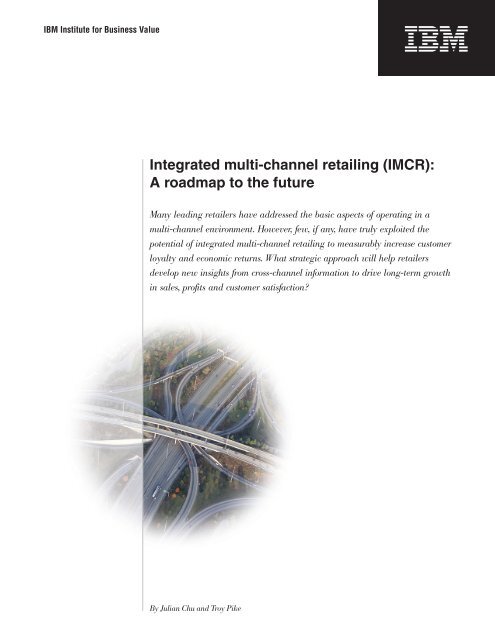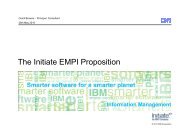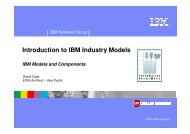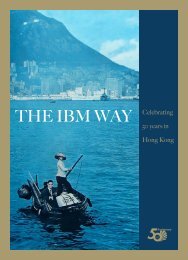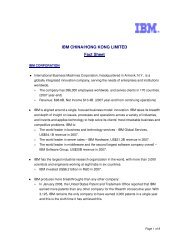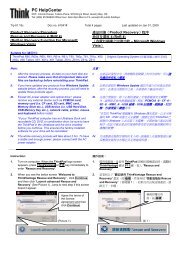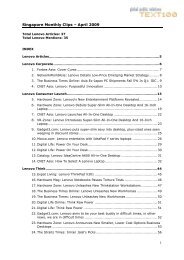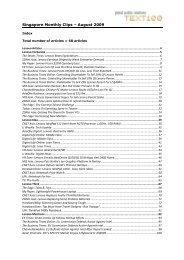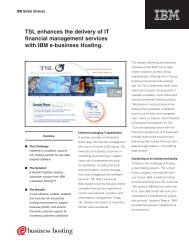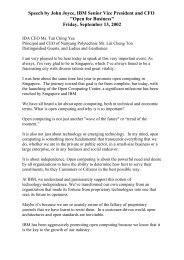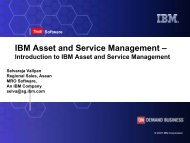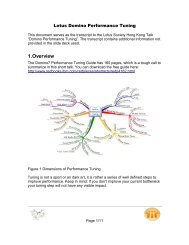Integrated multi-channel retailing (IMCR): A roadmap to the ... - IBM
Integrated multi-channel retailing (IMCR): A roadmap to the ... - IBM
Integrated multi-channel retailing (IMCR): A roadmap to the ... - IBM
You also want an ePaper? Increase the reach of your titles
YUMPU automatically turns print PDFs into web optimized ePapers that Google loves.
<strong>IBM</strong> Institute for Business Value<br />
<strong>Integrated</strong> <strong>multi</strong>-<strong>channel</strong> <strong>retailing</strong> (<strong>IMCR</strong>):<br />
A <strong>roadmap</strong> <strong>to</strong> <strong>the</strong> future<br />
Many leading retailers have addressed <strong>the</strong> basic aspects of operating in a<br />
<strong>multi</strong>-<strong>channel</strong> environment. However, few, if any, have truly exploited <strong>the</strong><br />
potential of integrated <strong>multi</strong>-<strong>channel</strong> <strong>retailing</strong> <strong>to</strong> measurably increase cus<strong>to</strong>mer<br />
loyalty and economic returns. What strategic approach will help retailers<br />
develop new insights from cross-<strong>channel</strong> information <strong>to</strong> drive long-term growth<br />
in sales, profits and cus<strong>to</strong>mer satisfaction?<br />
By Julian Chu and Troy Pike
<strong>Integrated</strong> <strong>multi</strong>-<strong>channel</strong> <strong>retailing</strong><br />
Contents<br />
2 Issue<br />
4 Analysis<br />
11 Implications<br />
15 Moving forward<br />
17 About <strong>the</strong> authors<br />
1<br />
Executive summary<br />
In <strong>to</strong>day’s rapidly changing, increasingly complex <strong>multi</strong>-<strong>channel</strong> retail environment, competi<strong>to</strong>rs<br />
face <strong>the</strong> overwhelming chore of simultaneously reversing <strong>the</strong> downward trend in cus<strong>to</strong>mer<br />
satisfaction and improving operational efficiency. This environment challenges retail executives<br />
<strong>to</strong> respond on several fronts:<br />
• Develop a unified understanding of a given cus<strong>to</strong>mer’s wants and needs as consumers<br />
become increasingly fragmented in <strong>the</strong> <strong>channel</strong>s <strong>the</strong>y use<br />
• Experiment with emerging technologies <strong>to</strong> improve cus<strong>to</strong>mer satisfaction and share<br />
of wallet, while tackling significant organization and process integration issues<br />
• Address <strong>to</strong>day’s pressing economic challenges, while still building <strong>the</strong> capabilities needed<br />
<strong>to</strong> compete successfully in <strong>the</strong> future.<br />
Dealing with <strong>the</strong>se issues necessitates that retailers alter <strong>the</strong>ir approach <strong>to</strong> <strong>the</strong> marketplace.<br />
Ra<strong>the</strong>r than focusing on maximizing <strong>the</strong> next transaction, <strong>the</strong> emphasis should be on optimizing<br />
cus<strong>to</strong>mer lifetime value and consumer spend across <strong>channel</strong>s. This entails leveraging consumer<br />
data throughout <strong>the</strong> enterprise <strong>to</strong> create valuable insights that improve both business and<br />
cus<strong>to</strong>mer value.<br />
To accomplish this transformation, retail executives need a clear <strong>roadmap</strong> that can help <strong>the</strong>m<br />
maintain tight linkage between cus<strong>to</strong>mer strategy, organization capabilities and technology.<br />
To make it <strong>to</strong> <strong>the</strong> next level, retailers need a clear perspective on how <strong>the</strong>y will build <strong>the</strong><br />
capabilities required <strong>to</strong> exploit <strong>the</strong> full potential of integrated <strong>multi</strong>-<strong>channel</strong> <strong>retailing</strong> (<strong>IMCR</strong>).<br />
Application of a Protect, Evolve, Transform (PET) framework <strong>to</strong> <strong>IMCR</strong> will help retailers<br />
evaluate <strong>the</strong> current state of <strong>the</strong>ir integration initiatives and assess future efforts:<br />
• Protect—Maintain competitive parity and protect existing revenue streams<br />
• Evolve—Significantly increase wallet share and cus<strong>to</strong>mer loyalty, as well as achieve<br />
large gains in productivity and efficiency<br />
• Transform—Change <strong>the</strong> basis of industry competition by developing defensible,<br />
long-term competitive strengths.<br />
<strong>Integrated</strong> <strong>multi</strong>-<strong>channel</strong> <strong>retailing</strong> <strong>IBM</strong> Institute for Business Value
<strong>Integrated</strong> <strong>multi</strong>-<strong>channel</strong> <strong>retailing</strong><br />
85<br />
80<br />
75<br />
70<br />
65<br />
2<br />
Retailers’ approach <strong>to</strong> <strong>multi</strong>-<strong>channel</strong> integration should be flexible enough <strong>to</strong> adjust <strong>to</strong> changes<br />
in <strong>the</strong> market, technology availability and cus<strong>to</strong>mer expectations. At <strong>the</strong> same time, it should<br />
remain focused on <strong>the</strong> fundamental goal of continuously enhancing <strong>the</strong> cus<strong>to</strong>mer experience<br />
through improved organizational collaboration and technological enablers. <strong>IMCR</strong> is not a<br />
technology module you can just drop in. Ra<strong>the</strong>r, it is a strategic, evolutionary path that<br />
retailers must follow <strong>to</strong> maintain <strong>the</strong>ir competitiveness in <strong>the</strong> short term and build a defensible<br />
competitive advantage over <strong>the</strong> long term.<br />
Issue<br />
As complexity increases, cus<strong>to</strong>mer satisfaction suffers<br />
Empowered by ever-increasing access <strong>to</strong> information and competing products and services,<br />
consumers are redefining <strong>the</strong> business context of retail. They are comfortable interacting<br />
with retailers through a wide variety of <strong>channel</strong>s—s<strong>to</strong>res, catalogs, Web sites, call centers and<br />
e-mail <strong>to</strong>day; and interactive TV, cell phones, kiosks and yet-<strong>to</strong>-be-invented digital devices,<br />
<strong>to</strong>morrow. While providing greater flexibility, alternate <strong>channel</strong>s are also creating increased<br />
complexity for consumers and retailers alike. This complexity might be contributing <strong>to</strong> <strong>the</strong><br />
greater-than-average erosion in <strong>the</strong> cus<strong>to</strong>mer satisfaction of certain retailers compared <strong>to</strong> <strong>the</strong><br />
national average across industries (see Figure 1).<br />
Figure 1. American cus<strong>to</strong>mer satisfaction index for select retailers 1<br />
Q4 94 Q4 95 Q4 96 Q4 97 Q4 98 Q4 99 Q4 00 Q4 01<br />
<strong>Integrated</strong> <strong>multi</strong>-<strong>channel</strong> <strong>retailing</strong> <strong>IBM</strong> Institute for Business Value<br />
Nordstrom (-6%)<br />
Wal-Mart (-6%)<br />
Cross-Industry Avg. (-2%)<br />
Albertson’s (-3%)<br />
Federated (-3%)
<strong>Integrated</strong> <strong>multi</strong>-<strong>channel</strong> <strong>retailing</strong><br />
3<br />
In this rapidly changing setting, retailers face <strong>the</strong> daunting task of improving waning cus<strong>to</strong>mer<br />
satisfaction even as consumer expectations and choices become greater than ever. In particular,<br />
<strong>the</strong> new <strong>multi</strong>-<strong>channel</strong> retail environment creates a major cus<strong>to</strong>mer relationship challenge for<br />
retailers: as consumers become increasingly fragmented in <strong>the</strong> <strong>channel</strong>s <strong>the</strong>y use, it becomes<br />
more difficult <strong>to</strong> have a comprehensive understanding of any given cus<strong>to</strong>mer’s wants and<br />
needs. For example, when Mrs. Jones came in<strong>to</strong> her neighborhood s<strong>to</strong>re every week <strong>to</strong> fill her<br />
shopping list, it was a straightforward task <strong>to</strong> “know <strong>the</strong> cus<strong>to</strong>mer.” But with <strong>to</strong>day’s intense<br />
marketplace competition, megas<strong>to</strong>res, lifestyle diversity and numerous modes of interaction, no<br />
one <strong>channel</strong> or company has a complete view of <strong>the</strong> cus<strong>to</strong>mer.<br />
Multi-<strong>channel</strong> retailers are addressing <strong>the</strong> basics<br />
While some e-commerce pioneers tried <strong>to</strong> strike it rich in <strong>the</strong> equity markets by setting<br />
up separate dot-com divisions, <strong>the</strong> folly of this approach soon became clear. Separation<br />
between online and s<strong>to</strong>re operations led <strong>to</strong> business practices and policies that frustrated<br />
and confused cus<strong>to</strong>mers. Likewise, investments in distinct online and offline functions—for<br />
example, merchandising, inven<strong>to</strong>ry management and marketing—became difficult <strong>to</strong> justify.<br />
Most retailers quickly changed course and moved <strong>to</strong> provide more integrated <strong>multi</strong>-<strong>channel</strong><br />
shopping experiences <strong>to</strong> cus<strong>to</strong>mers. Virtually all dot-com “spin-offs” have now been reconnected<br />
<strong>to</strong> <strong>the</strong>ir parent companies. Operational and strategic rationalization have challenged retailers<br />
<strong>to</strong> tackle significant organization and process integration issues, while at <strong>the</strong> same time,<br />
experimenting with emerging technologies <strong>to</strong> improve cus<strong>to</strong>mer satisfaction and share of wallet.<br />
Most <strong>multi</strong>-<strong>channel</strong> players have now adopted “standard practices” around integrated marketing,<br />
cus<strong>to</strong>mer service and returns management. Some notable examples include:<br />
• Circuit City offers a unique express pickup service that allows cus<strong>to</strong>mers, while shopping<br />
online, <strong>to</strong> determine if <strong>the</strong> products <strong>the</strong>y want are available at <strong>the</strong>ir local Circuit City s<strong>to</strong>re;<br />
items can <strong>the</strong>n be picked up <strong>to</strong> save on shipping charges and achieve more rapid fulfillment.<br />
• At Wal-Mart, an item can be returned <strong>to</strong> any <strong>channel</strong>, for any reason, and Wal-Mart Online<br />
even includes a postage-paid return label with every order so consumers don’t have <strong>to</strong> pay<br />
return shipping charges.<br />
<strong>Integrated</strong> <strong>multi</strong>-<strong>channel</strong> <strong>retailing</strong> <strong>IBM</strong> Institute for Business Value
<strong>Integrated</strong> <strong>multi</strong>-<strong>channel</strong> <strong>retailing</strong><br />
4<br />
Yet much more remains <strong>to</strong> be done<br />
These basic improvements do not go far enough, however. The steps taken by most retailers <strong>to</strong><br />
date are merely “table stakes” and have not enabled <strong>the</strong>m <strong>to</strong> build competitive advantages that<br />
significantly increase cus<strong>to</strong>mer loyalty and improve long-term financial strength. Consumers,<br />
with unmet expectations of <strong>channel</strong> synchronization and shopping ease, are still undecided<br />
about where <strong>to</strong> place <strong>the</strong>ir loyalty.<br />
Retailers recognize that increased wallet share and revenues will come in part from a<br />
deeper understanding of individual consumer needs, but <strong>the</strong>y are under more pressure<br />
than ever <strong>to</strong> drive near-term return on investment (ROI). Many are overtly changing <strong>the</strong>ir<br />
priorities <strong>to</strong> focus on tactical, cost-saving measures, ra<strong>the</strong>r than more strategic, growthoriented<br />
initiatives. At <strong>the</strong> same time, cus<strong>to</strong>mer demands and competitive intensity continue<br />
<strong>to</strong> rise, and industry competi<strong>to</strong>rs cannot sit still.<br />
The key challenge now is addressing <strong>to</strong>day’s pressing needs, while still building <strong>the</strong> capabilities<br />
needed <strong>to</strong> compete successfully in <strong>the</strong> future. To make it <strong>to</strong> <strong>the</strong> next level, retail executives<br />
need <strong>to</strong> have a clear perspective on how <strong>the</strong>y will, over time, make it possible <strong>to</strong> exploit <strong>the</strong><br />
full potential of <strong>IMCR</strong>.<br />
Analysis<br />
Multi-<strong>channel</strong> <strong>retailing</strong> is fundamental <strong>to</strong> successful <strong>retailing</strong><br />
In <strong>the</strong> few short years <strong>the</strong> Internet has been available <strong>to</strong> <strong>the</strong> mainstream public, consumers<br />
have embraced it for its convenience and ability <strong>to</strong> deliver extensive information about both<br />
products and retailers. At <strong>the</strong> same time, <strong>the</strong> traditional brick-and-mortar s<strong>to</strong>re remains <strong>the</strong><br />
<strong>channel</strong> of choice for most shopping occasions and will likely stay that way for <strong>the</strong> foreseeable<br />
future. It affords consumers <strong>the</strong> ability <strong>to</strong> <strong>to</strong>uch and examine products, obtain advice from<br />
sales associates, and get immediate gratification from purchasing.<br />
<strong>Integrated</strong> <strong>multi</strong>-<strong>channel</strong> <strong>retailing</strong> <strong>IBM</strong> Institute for Business Value
<strong>Integrated</strong> <strong>multi</strong>-<strong>channel</strong> <strong>retailing</strong><br />
5<br />
None<strong>the</strong>less, recent studies demonstrate how pervasive <strong>multi</strong>-<strong>channel</strong> shopping has become:<br />
According <strong>to</strong> research sponsored by Shop.org, an industry trade association, 78 percent of<br />
online shoppers also buy through a merchant’s physical s<strong>to</strong>res, and 45 percent of <strong>the</strong>m also<br />
buy using <strong>the</strong> catalog <strong>channel</strong> (that is, using phone, mail or fax). Similarly, 23 percent of<br />
catalog shoppers also make purchases on <strong>the</strong> company’s Web site. And while only 6 percent<br />
of s<strong>to</strong>re shoppers also buy online <strong>to</strong>day, that figure is undoubtedly growing (see Figure 2).<br />
Figure 2. Incidence of cross-<strong>channel</strong> purchasing 2<br />
S<strong>to</strong>re<br />
78%<br />
6%<br />
22%<br />
36%<br />
Online<br />
23%<br />
45%<br />
Catalog<br />
More significantly, consumers rely heavily on <strong>the</strong> Internet as a means of obtaining information<br />
about products and retailers, regardless of what <strong>channel</strong> <strong>the</strong>y ultimately use <strong>to</strong> buy. Shop.org<br />
found that roughly half of catalog shoppers and nearly three-quarters of s<strong>to</strong>re shoppers preferred<br />
<strong>to</strong> conduct <strong>the</strong>ir prepurchase research online—even though <strong>the</strong> vast majority of both groups still<br />
viewed offline <strong>channel</strong>s as <strong>the</strong> primary means of making purchases (see Figure 3).<br />
<strong>Integrated</strong> <strong>multi</strong>-<strong>channel</strong> <strong>retailing</strong> <strong>IBM</strong> Institute for Business Value
<strong>Integrated</strong> <strong>multi</strong>-<strong>channel</strong> <strong>retailing</strong><br />
6<br />
Figure 3. Channel preferences for different shopper groups 3<br />
Research<br />
online<br />
Research<br />
offline<br />
Online shoppers<br />
18%<br />
12%<br />
Buy offline<br />
55%<br />
16%<br />
Buy online<br />
Catalog shoppers<br />
24%<br />
37%<br />
25%<br />
14%<br />
<strong>Integrated</strong> <strong>multi</strong>-<strong>channel</strong> <strong>retailing</strong> <strong>IBM</strong> Institute for Business Value<br />
S<strong>to</strong>re shoppers<br />
55%<br />
23%<br />
18%<br />
5%<br />
Buy offline Buy online Buy offline Buy online<br />
Multi-<strong>channel</strong> consumers are also proving <strong>to</strong> be <strong>the</strong> most valuable within a retailer’s cus<strong>to</strong>mer<br />
base, tending <strong>to</strong> spend more and be more loyal. The Shop.org study, based on over 48000<br />
interviews of shoppers in all <strong>channel</strong>s, found compelling evidence of <strong>the</strong> value of <strong>multi</strong>-<strong>channel</strong><br />
shoppers <strong>to</strong> retailers’ bot<strong>to</strong>m line:<br />
• S<strong>to</strong>re shoppers who also buy online from <strong>the</strong> same retailer spend an average of US $600<br />
more annually in-s<strong>to</strong>re than typical s<strong>to</strong>re shoppers of that retailer.<br />
• Tri-<strong>channel</strong> shoppers, who buy from a retailer’s s<strong>to</strong>re, online and catalog <strong>channel</strong>s, purchase<br />
from a retailer’s s<strong>to</strong>re 70 percent more frequently than <strong>the</strong> average s<strong>to</strong>re cus<strong>to</strong>mer and<br />
110 percent more frequently from <strong>the</strong> retailer’s catalog.<br />
With <strong>the</strong> importance and value of having a strong <strong>multi</strong>-<strong>channel</strong> retail strategy becoming<br />
increasingly clear, a key challenge facing retail executives is how <strong>to</strong> progress from <strong>the</strong> recent<br />
period of ad hoc innovation and experimentation <strong>to</strong> a more-deliberate, forward-looking approach.
<strong>Integrated</strong> <strong>multi</strong>-<strong>channel</strong> <strong>retailing</strong><br />
7<br />
Retailers will progress through three major stages of <strong>IMCR</strong> adoption<br />
How can retail executives assess <strong>the</strong>ir current state of <strong>multi</strong>-<strong>channel</strong> readiness? Where are<br />
current initiatives leading? What capabilities will be required in <strong>the</strong> future? To begin answering<br />
<strong>the</strong>se important questions, it helps <strong>to</strong> have a <strong>roadmap</strong> that articulates what is required <strong>to</strong>day<br />
and in <strong>the</strong> future. One approach, presented here, is <strong>to</strong> evaluate <strong>the</strong> current state of integration<br />
initiatives and assess future efforts by utilizing a Protect, Evolve, Transform (PET) framework:<br />
• Protect—The first stage of <strong>IMCR</strong> focuses on maintaining competitive parity—making<br />
initial forays in<strong>to</strong> <strong>the</strong> <strong>multi</strong>-<strong>channel</strong> marketplace and improving obvious deficiencies in <strong>the</strong><br />
consumer’s shopping experience.<br />
• Evolve—In <strong>the</strong> next phase, retailers can achieve significant incremental revenue and<br />
efficiency gains by making specific parts of <strong>the</strong>ir businesses (that is, individual business<br />
processes) considerably more cus<strong>to</strong>mer-centric. The central challenge in this stage is <strong>to</strong><br />
create an integrated cross-<strong>channel</strong> view of cus<strong>to</strong>mer needs and patterns and <strong>to</strong> respond<br />
in a coordinated fashion along all cus<strong>to</strong>mer <strong>to</strong>uch points.<br />
• Transform—Ultimately, <strong>the</strong> full potential of <strong>IMCR</strong> can be achieved when retailers are able<br />
<strong>to</strong> effectively employ deep insights about marketplace needs and preferences—of not only<br />
<strong>the</strong>ir existing cus<strong>to</strong>mers but also potential cus<strong>to</strong>mers <strong>the</strong>y are seeking <strong>to</strong> acquire—<strong>to</strong> effect<br />
changes back through <strong>the</strong> entire extended enterprise value chain.<br />
Taking this framework down a level, <strong>multi</strong>-<strong>channel</strong> initiatives at each stage share some<br />
common characteristics (see Figure 4), which retail executives can use <strong>to</strong> assess <strong>the</strong>ir progress<br />
and develop a long-term plan. For example, focusing on sales and marketing, have you<br />
successfully addressed <strong>the</strong> basic requirements of conducting commerce and providing good<br />
cus<strong>to</strong>mer service in <strong>multi</strong>ple <strong>channel</strong>s? Are you effectively leveraging all means of generating<br />
awareness and driving <strong>the</strong> right “traffic” from one <strong>channel</strong> <strong>to</strong> ano<strong>the</strong>r (e.g., URLs everywhere,<br />
s<strong>to</strong>re associates educating cus<strong>to</strong>mers about <strong>the</strong> Web site, easy-<strong>to</strong>-use s<strong>to</strong>re loca<strong>to</strong>rs on <strong>the</strong> site)?<br />
<strong>Integrated</strong> <strong>multi</strong>-<strong>channel</strong> <strong>retailing</strong> <strong>IBM</strong> Institute for Business Value
<strong>Integrated</strong> <strong>multi</strong>-<strong>channel</strong> <strong>retailing</strong><br />
8<br />
Retailers that have mastered <strong>the</strong>se “table stakes” initiatives are likely moving forward <strong>to</strong><br />
<strong>the</strong> Evolve stage—developing <strong>the</strong> infrastructure and expertise needed <strong>to</strong> conduct promotional<br />
and cross-selling initiatives that successfully make use of cross-<strong>channel</strong> cus<strong>to</strong>mer data. Firms<br />
should be exploring ways of measuring and improving lifetime cus<strong>to</strong>mer value, ra<strong>the</strong>r than<br />
taking a transaction-by-transaction view. A key enabler of such programs is <strong>the</strong> creation of<br />
an integrated cus<strong>to</strong>mer database—no small task in itself. Fur<strong>the</strong>r down <strong>the</strong> road, <strong>the</strong> most-<br />
advanced competi<strong>to</strong>rs will Transform how <strong>the</strong>y sell by harnessing that data at individual<br />
or household levels <strong>to</strong> drive au<strong>to</strong>mated <strong>channel</strong> activities based on sophisticated predictive<br />
modeling and o<strong>the</strong>r technology-enabled mechanisms.<br />
Looking now at process and organizational integration, most retailers <strong>to</strong>day are still in stage<br />
one: many key functions are managed separately by <strong>channel</strong>, and conflicting employee incentives<br />
across <strong>channel</strong>s remain a thorny problem…not <strong>to</strong> mention <strong>the</strong> challenge of determining<br />
ROI for <strong>multi</strong>-<strong>channel</strong> initiatives. For many retailers, some key functions, such as inven<strong>to</strong>ry<br />
management and merchandising, have already moved in<strong>to</strong> <strong>the</strong> Evolve stage and are managed<br />
in a unified fashion <strong>to</strong> support all of <strong>the</strong>ir <strong>channel</strong>s. A few progressive companies are also<br />
beginning <strong>to</strong> manage key processes from a true <strong>multi</strong>-<strong>channel</strong> perspective—for instance, by<br />
creating a corporate-wide cus<strong>to</strong>mer relationship management (CRM) team that works across<br />
all lines of business. In <strong>the</strong> relatively near future, <strong>the</strong> most successful retailers will have<br />
transformed <strong>the</strong>mselves by figuring out how <strong>to</strong> drive fact-based insights back in<strong>to</strong> <strong>the</strong>ir core<br />
management processes in near realtime, making <strong>the</strong>ir organizations highly responsive <strong>to</strong> <strong>the</strong><br />
shifting demands of <strong>the</strong> market.<br />
<strong>Integrated</strong> <strong>multi</strong>-<strong>channel</strong> <strong>retailing</strong> <strong>IBM</strong> Institute for Business Value
<strong>Integrated</strong> <strong>multi</strong>-<strong>channel</strong> <strong>retailing</strong><br />
Strategic focus<br />
Sales and marketing<br />
Cus<strong>to</strong>mer analytics<br />
Technology architecture<br />
Process/org integration<br />
9<br />
Figure 4. Characteristics of <strong>IMCR</strong> across three stages<br />
Protect Evolve Transform<br />
Maintain competitive parity<br />
Defend existing revenue streams<br />
Build basic <strong>multi</strong>-<strong>channel</strong> cus<strong>to</strong>mer<br />
access and awareness<br />
Identify cus<strong>to</strong>mers and collect<br />
transaction data in a single <strong>channel</strong><br />
Deploy new infrastructure and point<br />
solutions in individual <strong>channel</strong>s<br />
Manage functions within a<br />
given <strong>channel</strong><br />
Resolve conflicts in incentives<br />
and metrics<br />
Source: <strong>IBM</strong> Institute for Business Value.<br />
Significantly grow share of wallet and<br />
cus<strong>to</strong>mer loyalty<br />
Achieve large gains in efficiency<br />
and productivity<br />
Drive cus<strong>to</strong>mized cross-sell, up-sell,<br />
and loyalty programs across <strong>channel</strong>s<br />
Understand and track cus<strong>to</strong>mer<br />
behavior across <strong>channel</strong>s<br />
Integrate “islands” of infrastructure<br />
and data<br />
Build flexible systems across lines<br />
of business<br />
Manage enterprise processes across<br />
all <strong>channel</strong>s<br />
<strong>Integrated</strong> <strong>multi</strong>-<strong>channel</strong> <strong>retailing</strong> <strong>IBM</strong> Institute for Business Value<br />
Change <strong>the</strong> basis of industry competition<br />
Create defensible, long-term<br />
competitive strengths<br />
Optimize individual/household-level<br />
marketing through predictive analysis<br />
and au<strong>to</strong>mated systems<br />
Develop insights via integrated view of<br />
own cus<strong>to</strong>mers and external market<br />
Leverage third-party technology/<br />
e-business capabilities “on demand”<br />
Drive marketplace insights all <strong>the</strong> way<br />
back through <strong>the</strong> enterprise value chain<br />
Mapping various aspects of <strong>multi</strong>-<strong>channel</strong> <strong>retailing</strong> initiatives across <strong>the</strong> PET framework<br />
illustrates where a retailer stands and what needs <strong>to</strong> be done <strong>to</strong> prepare for <strong>the</strong> future. O<strong>the</strong>r<br />
key dimensions include overall strategic focus, sophistication of cus<strong>to</strong>mer and marketplace<br />
analytics, and degree of flexibility and integration of <strong>the</strong> underlying technology architecture.<br />
You can also identify o<strong>the</strong>rs at more-detailed, tactical levels if required.<br />
Although <strong>the</strong>se dimensions are clearly interdependent, it is also important <strong>to</strong> realize that<br />
companies do not have <strong>to</strong> move through <strong>the</strong> stages in lockstep across all aspects of <strong>the</strong>ir<br />
operations. Many retailers are, in fact, at varying levels in <strong>the</strong>ir integration efforts, depending<br />
on what function or process is being considered. In some cases, retailers may be at <strong>the</strong><br />
Protect stage in one part of <strong>the</strong>ir value chains, while moving forward with Evolve initiatives<br />
in o<strong>the</strong>r parts of <strong>the</strong>ir businesses.
<strong>Integrated</strong> <strong>multi</strong>-<strong>channel</strong> <strong>retailing</strong><br />
10<br />
For instance, Best Buy Co., Inc. operates distinct merchandising departments for its online<br />
and offline operations, offering a subset of its s<strong>to</strong>re merchandise online—characteristic of<br />
a Protect-stage approach. However, from a sales and cus<strong>to</strong>mer service perspective, <strong>the</strong><br />
company has begun a pilot program equipping its sales associates with PDAs, used<br />
<strong>to</strong> instantly access product information while assisting cus<strong>to</strong>mers in <strong>the</strong> s<strong>to</strong>re—a more<br />
leading-edge, Evolve initiative.<br />
In <strong>the</strong> case of Recreational Equipment Inc. (REI), its online division maintains separate<br />
merchandising and inven<strong>to</strong>ry management departments (<strong>the</strong> Protect stage). However, REI<br />
s<strong>to</strong>res also provide real-time access <strong>to</strong> online inven<strong>to</strong>ry through in-s<strong>to</strong>re kiosks and Web-based<br />
POS systems (<strong>the</strong> Evolve stage). Across <strong>the</strong> board, retailers are looking at innovative ways <strong>to</strong><br />
improve <strong>the</strong> cus<strong>to</strong>mer experience and extend <strong>the</strong> reach of <strong>the</strong>ir various <strong>channel</strong>s.<br />
This view of <strong>multi</strong>-<strong>channel</strong> retail integration illustrates that it is not a single project that can<br />
be accomplished quickly, nor is it a process that is ever fully completed. Ra<strong>the</strong>r, retailers<br />
must recognize that integration needs <strong>to</strong> occur over time, adjusting <strong>to</strong> changes in <strong>the</strong> market,<br />
technology availability and cus<strong>to</strong>mer expectations. In <strong>the</strong> end, <strong>the</strong> goal of <strong>multi</strong>-<strong>channel</strong><br />
integration is <strong>to</strong> continuously enhance <strong>the</strong> cus<strong>to</strong>mer experience through improved organizational<br />
collaboration and technological enablers.<br />
<strong>Integrated</strong> <strong>multi</strong>-<strong>channel</strong> <strong>retailing</strong> <strong>IBM</strong> Institute for Business Value
<strong>Integrated</strong> <strong>multi</strong>-<strong>channel</strong> <strong>retailing</strong><br />
11<br />
Implications<br />
Advanced cus<strong>to</strong>mer analytics are <strong>the</strong> central challenge<br />
Retailers can significantly influence cus<strong>to</strong>mer satisfaction and shopping behavior by clearly<br />
framing expectations and actively delivering what is promised. This process begins with<br />
an accurate understanding of continuously evolving cus<strong>to</strong>mer needs. So, why are so few<br />
companies using cus<strong>to</strong>mer data effectively? A number of difficult structural challenges are a<br />
large part of <strong>the</strong> problem:<br />
• Lack of rich analytical <strong>to</strong>ols <strong>to</strong> provide true insight in<strong>to</strong> cus<strong>to</strong>mer behavior<br />
• Lack of au<strong>to</strong>mated processes that translate cus<strong>to</strong>mer data and insights in<strong>to</strong> actions<br />
• Limited means <strong>to</strong> transfer intelligence gained from cus<strong>to</strong>mer data across functional areas.<br />
Although most retailers are drowning in transactional data about <strong>the</strong>ir cus<strong>to</strong>mers, <strong>the</strong> real<br />
task is <strong>to</strong> transform that data in<strong>to</strong> useful intelligence that can help drive business decisions.<br />
In <strong>the</strong> end, being “integrated” is not about being able <strong>to</strong> push consistent messages across<br />
all your <strong>channel</strong>s. It’s about moving beyond traditional retail management methods so that<br />
you can identify demonstrable links and causal relationships between events in one <strong>channel</strong><br />
and results in ano<strong>the</strong>r.<br />
Advances in <strong>the</strong> use of complex analytical techniques will be crucial <strong>to</strong> delivering improved<br />
<strong>channel</strong> efficiencies and consumer value and satisfaction. Near-term improvement requires<br />
migration from manual, single-event focused promotions, <strong>to</strong> au<strong>to</strong>mated, <strong>multi</strong>-variable analytics.<br />
Ra<strong>the</strong>r than concentrating on optimizing <strong>the</strong> next transaction, retailers need <strong>to</strong> focus on<br />
maximizing <strong>the</strong> economic value of cus<strong>to</strong>mers across <strong>channel</strong>s and over <strong>the</strong> cus<strong>to</strong>mer’s lifetime.<br />
Cus<strong>to</strong>mer-experience modeling, au<strong>to</strong>nomic computing and probabilistic estimation are just a<br />
few of <strong>the</strong> <strong>to</strong>ols that are showing strong potential <strong>to</strong> help retailers achieve <strong>the</strong>se goals.<br />
<strong>Integrated</strong> <strong>multi</strong>-<strong>channel</strong> <strong>retailing</strong> <strong>IBM</strong> Institute for Business Value
<strong>Integrated</strong> <strong>multi</strong>-<strong>channel</strong> <strong>retailing</strong><br />
12<br />
It’s all about Systematic Intelligence<br />
The critical role that advanced cus<strong>to</strong>mer analytics will play in <strong>the</strong> future <strong>multi</strong>-<strong>channel</strong> retail<br />
model raises an important point: over <strong>the</strong> long term, <strong>IMCR</strong> is fundamentally concerned with<br />
transforming <strong>the</strong> retail enterprise end-<strong>to</strong>-end. In many respects, true CRM (not just e-mail<br />
campaign management) and <strong>IMCR</strong> are so intertwined that it’s difficult <strong>to</strong> tell which is a subset<br />
of <strong>the</strong> o<strong>the</strong>r, or whe<strong>the</strong>r <strong>the</strong>y’re simply <strong>the</strong> same thing. On ano<strong>the</strong>r front, massive investments<br />
in Enterprise Resource Planning (ERP) systems have been made <strong>to</strong> give retail executives<br />
improved visibility and control over internal business operations. But <strong>the</strong>ir true power will be<br />
realized only when <strong>the</strong> knowledge locked in <strong>the</strong>se systems is opened <strong>to</strong> applications facing<br />
consumers and external partners.<br />
e-business is fundamentally about improving <strong>the</strong> utility of information in order <strong>to</strong> drive<br />
increased economic value. The ability <strong>to</strong> capture consumer information and integrate it with<br />
enterprise data <strong>to</strong> generate valuable inferences needs <strong>to</strong> become a retail core competency.<br />
Systematic Intelligence refers <strong>to</strong> this concept of leveraging data throughout <strong>the</strong> enterprise<br />
<strong>to</strong> au<strong>to</strong>matically create valuable insights that improve business and cus<strong>to</strong>mer value through<br />
enterprise processes. Viewed broadly, integrated <strong>multi</strong>-<strong>channel</strong> data can be harnessed <strong>to</strong><br />
drive operational improvements throughout <strong>the</strong> retail value chain. Improved turnover, reduced<br />
inven<strong>to</strong>ry-carrying costs and lower distribution expenses can all complement <strong>the</strong> increased<br />
sales margin promised from <strong>IMCR</strong> (see Figure 5).<br />
Figure 5. Systematic Intelligence: Converting data in<strong>to</strong> useable insights across <strong>the</strong> retail enterprise<br />
Manage<br />
supply chain<br />
Au<strong>to</strong>mated analytics<br />
Probabilistic estimation<br />
Manage<br />
brand<br />
<strong>Integrated</strong> <strong>multi</strong>-<strong>channel</strong> <strong>retailing</strong> <strong>IBM</strong> Institute for Business Value<br />
Manage<br />
cus<strong>to</strong>mers<br />
Predictive modeling<br />
Suppliers Consumer insight<br />
Consumers<br />
Source: <strong>IBM</strong> Institute for Business Value.<br />
Manage<br />
products &<br />
services<br />
Manage<br />
<strong>channel</strong>s<br />
Decision support
<strong>Integrated</strong> <strong>multi</strong>-<strong>channel</strong> <strong>retailing</strong><br />
13<br />
A forward-looking IT strategy is crucial <strong>to</strong> achieving <strong>the</strong>se objectives. For instance, without<br />
a “delivery system” capable of empowering employees, from corporate <strong>to</strong> <strong>the</strong> s<strong>to</strong>re, retailers<br />
cannot fully utilize <strong>the</strong> information <strong>the</strong>y’ve collected <strong>to</strong> improve organizational effectiveness and<br />
loyalty. S<strong>to</strong>re POS systems must be managed not from a transaction-efficiency standpoint but<br />
with a service-effectiveness focus. Regardless of form fac<strong>to</strong>r, whe<strong>the</strong>r handheld, self-scanning<br />
or traditional, <strong>the</strong> POS systems of <strong>to</strong>morrow must be capable of linking <strong>to</strong> many devices and<br />
applications, and must deliver insightful information <strong>to</strong> consumers and associates. Ra<strong>the</strong>r than<br />
focusing on maximizing <strong>the</strong> next transaction, <strong>the</strong> smarter POS mechanism will be a marketing<br />
and service-delivery <strong>to</strong>ol, bent on optimizing cus<strong>to</strong>mer lifetime value and consumer spend<br />
across <strong>channel</strong>s.<br />
Take a comprehensive view of <strong>IMCR</strong><br />
As with many technology-intensive efforts, retailers struggle with <strong>multi</strong>-<strong>channel</strong> initiatives<br />
often because decisions are made in a vacuum—without sufficient regard <strong>to</strong> strategic, business<br />
process, organizational or technological issues. Retailers need <strong>to</strong> take both a <strong>to</strong>p-down and<br />
a bot<strong>to</strong>m-up view and ensure tight linkage between <strong>the</strong> cus<strong>to</strong>mer experience, organizational<br />
processes and capabilities, and enabling technologies (see Figure 6):<br />
• Cus<strong>to</strong>mer-facing requirements drive <strong>the</strong> <strong>to</strong>p-down perspective. What types of service outputs<br />
are demanded by different cus<strong>to</strong>mers from each <strong>channel</strong> of interaction? What kinds of<br />
cus<strong>to</strong>mer experiences is <strong>the</strong> company trying <strong>to</strong> create? What will it take <strong>to</strong> fulfill <strong>the</strong><br />
promised consumer value proposition?<br />
• Business-facing considerations drive <strong>the</strong> bot<strong>to</strong>m-up view. How do we achieve our business<br />
and financial goals? How can asset productivity be maximized? What changes are required<br />
in <strong>the</strong> organization? What technology and skill gaps must be filled?<br />
<strong>Integrated</strong> <strong>multi</strong>-<strong>channel</strong> <strong>retailing</strong> <strong>IBM</strong> Institute for Business Value
<strong>Integrated</strong> <strong>multi</strong>-<strong>channel</strong> <strong>retailing</strong><br />
14<br />
Figure 6. Holistic approach <strong>to</strong> integrated <strong>multi</strong>-<strong>channel</strong> <strong>retailing</strong><br />
Cus<strong>to</strong>mer and<br />
marketplace insights<br />
What <strong>channel</strong> service outputs do cus<strong>to</strong>mers demand?<br />
What cross-<strong>channel</strong> cus<strong>to</strong>mer experiences do we want <strong>to</strong> deliver?<br />
Strategy definition and alignment<br />
Cus<strong>to</strong>mer experience<br />
optimization<br />
Data management and analytics<br />
<strong>Integrated</strong> <strong>multi</strong>-<strong>channel</strong> <strong>retailing</strong> <strong>IBM</strong> Institute for Business Value<br />
<strong>Integrated</strong> <strong>channel</strong>s<br />
architecture<br />
Process and<br />
organizational design<br />
How can we consistently deliver on cus<strong>to</strong>mer and management expectations?<br />
What organizational and technology architecture is needed?<br />
Source: <strong>IBM</strong> Institute for Business Value.
<strong>Integrated</strong> <strong>multi</strong>-<strong>channel</strong> <strong>retailing</strong><br />
15<br />
Moving forward<br />
The key for retailers is <strong>to</strong> marry <strong>the</strong> <strong>to</strong>p-down and bot<strong>to</strong>m-up perspectives with equal<br />
weight—<strong>to</strong>o many companies focus excessively on internal capabilities and constraints,<br />
seeking <strong>to</strong> optimize <strong>the</strong>ir operations ra<strong>the</strong>r than add value <strong>to</strong> <strong>the</strong> consumer. Addressing<br />
<strong>the</strong> key linkages in a holistic way is a critical success fac<strong>to</strong>r in delivering on <strong>the</strong> promise<br />
of <strong>IMCR</strong>. A comprehensive approach should address <strong>the</strong> following issues:<br />
Strategy definition and alignment—Determine what you want <strong>to</strong> achieve first. How<br />
aligned are your business and IT strategies? Agree on <strong>the</strong> process and criteria you will use <strong>to</strong><br />
prioritize possible initiatives and make investment decisions. For example, potential integration<br />
efforts could be prioritized based on <strong>the</strong>ir expected impact <strong>to</strong> <strong>the</strong> organization and <strong>the</strong>ir<br />
difficulty in terms of implementation. Identify measurable results against which you can track<br />
progress. Are incentives for employees and managers across different <strong>channel</strong>s and functions<br />
aligned? Will <strong>the</strong>y encourage <strong>the</strong> desired behavior?<br />
Cus<strong>to</strong>mer and marketplace insights—Ensure that you have an up-<strong>to</strong>-date understanding of<br />
<strong>the</strong> preferences and profitability of your key cus<strong>to</strong>mer segments (which is crucial <strong>to</strong> prioritizing<br />
investments). Understand not just what <strong>the</strong>y buy and who <strong>the</strong>y are, but also why <strong>the</strong>y buy.<br />
Learning attractive traits of highly profitable cus<strong>to</strong>mers allows retailers <strong>to</strong> identify mid-range<br />
cus<strong>to</strong>mers exhibiting high value potential. Market research and segmentation analysis should<br />
be conducted on not only your own cus<strong>to</strong>mer and transaction data but also on <strong>the</strong> addressable<br />
market at large—o<strong>the</strong>rwise, you might overlook <strong>the</strong> needs of potential cus<strong>to</strong>mers.<br />
Cus<strong>to</strong>mer experience optimization—Develop a strong understanding of how cus<strong>to</strong>mers<br />
move through <strong>the</strong> buying cycle. Where are <strong>the</strong> existing pain points from cus<strong>to</strong>mer, employee<br />
and business perspectives? Based on <strong>the</strong> cus<strong>to</strong>mer insights developed above, take steps <strong>to</strong> offer<br />
<strong>the</strong> choices and services that your target cus<strong>to</strong>mers deem important in any given <strong>channel</strong>. Do<br />
<strong>the</strong>y want knowledgeable sales help, or easy self-service? The answer might vary by <strong>channel</strong><br />
and product category.<br />
<strong>Integrated</strong> <strong>multi</strong>-<strong>channel</strong> <strong>retailing</strong> <strong>IBM</strong> Institute for Business Value
<strong>Integrated</strong> <strong>multi</strong>-<strong>channel</strong> <strong>retailing</strong><br />
16<br />
<strong>Integrated</strong> <strong>channel</strong>s architecture—Deploy <strong>the</strong> systems needed <strong>to</strong> deliver ideal cus<strong>to</strong>mer<br />
experiences and <strong>to</strong> empower your employees. Build <strong>the</strong> necessary linkages between point<br />
systems. Evaluate legacy systems’ ability <strong>to</strong> meet future needs, and identify gaps and<br />
alternatives. How easily will new systems integrate with existing infrastructure? How can<br />
you avoid creating new “islands” of data?<br />
Process and organizational design—Evaluate business-process impacts in tandem with IT<br />
planning. How must processes, organizational structure and employee skills be changed <strong>to</strong><br />
deliver ideal cus<strong>to</strong>mer experiences? What initial steps can you take? Ensure that you have an<br />
effective governance model in place. As decisions increasingly affect teams across departments,<br />
lines of business and <strong>channel</strong>s, how will inevitable conflicts be resolved? What changes are<br />
needed <strong>to</strong> move <strong>the</strong> organization from a short-term, product-focused orientation <strong>to</strong> an emphasis<br />
on lifetime cus<strong>to</strong>mer value?<br />
Data management and analytics—Continue (or begin) building a unified data warehouse<br />
that ga<strong>the</strong>rs critical cus<strong>to</strong>mer information generated from all your <strong>channel</strong>s of interaction; or,<br />
at <strong>the</strong> very least, develop <strong>the</strong> capability <strong>to</strong> run analytics and obtain an integrated view across<br />
your <strong>multi</strong>ple data reposi<strong>to</strong>ries. Experiment with advanced analytical applications that move<br />
beyond <strong>to</strong>day’s single-<strong>channel</strong>, single-event packages <strong>to</strong>wards <strong>the</strong> future of cross-<strong>channel</strong>,<br />
predictive loyalty modeling.<br />
<strong>Integrated</strong> <strong>multi</strong>-<strong>channel</strong> <strong>retailing</strong> is clearly not a technology module that you can just drop<br />
in. Ra<strong>the</strong>r, it is a strategic, evolutionary path that retailers must follow <strong>to</strong> maintain <strong>the</strong>ir<br />
competitiveness in <strong>the</strong> short term and build defensible competitive advantage over <strong>the</strong> long<br />
term. This path can lead <strong>to</strong> stellar cus<strong>to</strong>mer relationships and dramatically improved operational<br />
effectiveness—derived from consumer dialogue, advanced data analytics and infrastructure<br />
integration. To avoid getting lost along <strong>the</strong> way, retail executives need <strong>to</strong> have a clear <strong>roadmap</strong><br />
that helps <strong>the</strong>m maintain tight linkage between cus<strong>to</strong>mer strategy, organization capabilities<br />
and technology.<br />
<strong>Integrated</strong> <strong>multi</strong>-<strong>channel</strong> <strong>retailing</strong> <strong>IBM</strong> Institute for Business Value
<strong>Integrated</strong> <strong>multi</strong>-<strong>channel</strong> <strong>retailing</strong><br />
17<br />
About <strong>the</strong> authors<br />
Julian Chu is <strong>the</strong> Distribution Sec<strong>to</strong>r team leader in <strong>the</strong> <strong>IBM</strong> Institute for Business Value.<br />
He specializes in helping executives in <strong>the</strong> retail and consumer goods industries develop<br />
and implement leading-edge e-business ventures and initiatives. Julian can be reached at<br />
jjchu@us.ibm.com.<br />
Troy Pike is <strong>the</strong> retail industry lead for <strong>the</strong> <strong>IBM</strong> Institute for Business Value. Troy focuses on<br />
performing in-depth analyses of issues that have strategic implications for senior executives in<br />
<strong>the</strong> retail industry. Troy can be reached at tpike@us.ibm.com.<br />
Contribu<strong>to</strong>rs<br />
Todd Gurley, Principal, <strong>IBM</strong> Strategy and Change Consulting<br />
Laurent Stanevich, Managing Principal, <strong>IBM</strong> Strategy and Change Consulting<br />
The <strong>IBM</strong> Institute for Business Value develops fact-based strategic insights for senior business<br />
executives around critical industry-specific and cross-industry issues. Clients in <strong>the</strong> Institute’s<br />
member programs—<strong>the</strong> <strong>IBM</strong> Business Value Alliance and <strong>the</strong> <strong>IBM</strong> Institute for Knowledgebased<br />
Organizations—benefit from access <strong>to</strong> in-depth consulting studies, a community of peers,<br />
and dialogue with <strong>IBM</strong> strategic advisors. These programs help executives realize business<br />
value in an environment of rapid, technology-enabled competitive change. You may contact <strong>the</strong><br />
authors or send e-mail <strong>to</strong> bva@us.ibm.com for more information on <strong>the</strong>se programs.<br />
References<br />
1 American Cus<strong>to</strong>mer Satisfaction Index (ACSI) Survey, by University of Michigan,<br />
American Society for Quality and CFI Group.<br />
2 The Multi-Channel Retail Report Executive Summary, 2001, by Shop.org, J.C Williams<br />
Group, and BizRate.com.<br />
3 Ibid.<br />
<strong>Integrated</strong> <strong>multi</strong>-<strong>channel</strong> <strong>retailing</strong> <strong>IBM</strong> Institute for Business Value
© Copyright <strong>IBM</strong> Corporation 2002<br />
<strong>IBM</strong> Global Services<br />
Route 100<br />
Somers, NY 10589<br />
U.S.A.<br />
Produced in <strong>the</strong> United States of America<br />
03-02<br />
All Rights Reserved<br />
<strong>IBM</strong> and <strong>the</strong> <strong>IBM</strong> logo are registered trademarks<br />
of International Business Machines Corporation<br />
in <strong>the</strong> United States, o<strong>the</strong>r countries, or both.<br />
O<strong>the</strong>r company, product and service names<br />
may be trademarks or service marks of o<strong>the</strong>rs.<br />
References in this publication <strong>to</strong> <strong>IBM</strong> products<br />
and services do not imply that <strong>IBM</strong> intends<br />
<strong>to</strong> make <strong>the</strong>m available in all countries in which<br />
<strong>IBM</strong> operates.<br />
G510-1660-00


